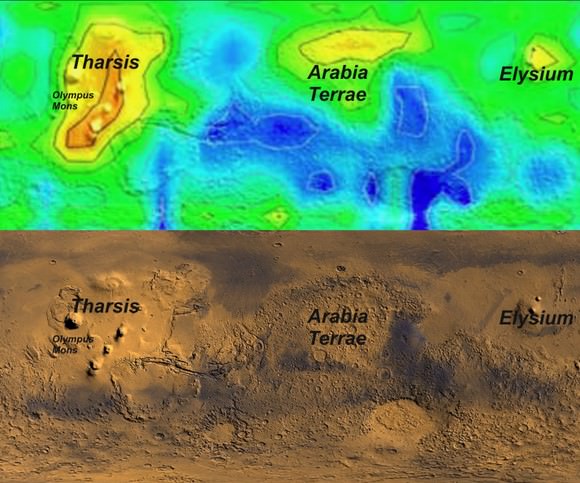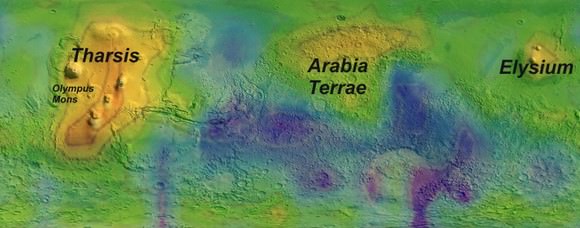Mars’ atmosphere consists of 95% carbon dioxide, 3% nitrogen, 1.6% argon, and contains small amounts of oxygen and water, as well as trace amounts of methane. The methane – although small in percentage – might be the most intriguing because the source of this very short-lived gas remains a mystery. And the mystery has just gotten a little more puzzling, as the lifetime of methane in Mars atmosphere appears to be even shorter than scientists had originally thought. Using observations from the Mars Global Surveyor — which functioned in orbit around for almost ten years – a group of scientists from Italy have determined the methane in the atmosphere of Mars lasts less than a year.
Scientists Sergio Fonti (Università del Salento) and Giuseppe Marzo (NASA Ames) reported their findings of evolution of the methane over three Martian years at the European Planetary Science Congress in Rome.
“Only small amounts of methane are present in the Martian atmosphere, coming from very localized sources,” said Fonti. “ We’ve looked at changes in concentrations of the gas and found that there are seasonal and also annual variations. The source of the methane could be geological activity or it could be biological – we can’t tell at this point. However, it appears that the upper limit for methane lifetime is less than a year in the Martian atmosphere.”
Levels of methane are highest in autumn in the northern hemisphere, with localized peaks of 70 parts per billion, although methane can be detected across most of the planet at this time of year. There is a sharp decrease in winter, with only a faint band between 40-50 degrees north. Concentrations start to build again in spring and rise more rapidly in summer, spreading across the planet.
“One of the interesting things that we’ve found is that in summer, although the general distribution pattern is much the same as in autumn, there are actually higher levels of methane in the southern hemisphere. This could be because of the natural circulation occurring in the atmosphere, but has to be confirmed by appropriate computer simulations,” said Fonti.

There are three regions in the northern hemisphere where methane concentrations are systematically higher: Tharsis and Elysium, the two main volcano provinces, and Arabia Terrae, which has high levels of underground water ice. Levels are highest over Tharsis, where geological processes, including magmatism, hydrothermal and geothermal activity could be ongoing.
“It’s evident that the highest concentrations are associated with the warmest seasons and locations where there are favorable geological – and hence biological – conditions such as geothermal activity and strong hydration. The higher energy available in summer could trigger the release of gases from geological processes or outbreaks of biological activity,” said Fonti.
The mechanisms for removing methane from the atmosphere are also not clear. Photochemical processes would not break down the gas quickly enough to match observations. However, wind driven processes can add strong oxidisers to the atmosphere, such as the highly reactive salt perchlorate, which could soak up methane much more rapidly.
Martian years are nearly twice as long as Earth years. The team used observations from the Thermal Emission Spectrometer (TES) on Mars Global Surveyor between July 1999 and October 2004. The team studied one of the characteristic spectral features of methane in nearly 3 million TES observations, averaging data together to eliminate noise.
“Our study is the first time that data from an orbiting spectrometer has been used to monitor methane over an extended period, “ Fonti said. “The huge TES dataset has allowed us to follow the methane cycle in the Martian atmosphere with unprecedented accuracy and completeness. Our observations will be very useful in constraining the origins and significance of Martian methane.”
Methane was first detected in the Martian atmosphere by ground based telescopes in 2003 and confirmed a year later by ESA’s Mars Express spacecraft. Last year, observations using ground based telescopes showed the first evidence of a seasonal cycle.


We should really get a rover roving around Tharsis. That seems to be the most interesting of all the regions of Mars.
Too bad that the high altitude makes landings difficult there. But perhaps a baloon system could some day be used to transport a rover to the area…
Hmm… What a conundrum! Its interesting that the Methane concentrations are near volcanic areas. A couple thoughts immediately come to mind. First, this seems to indicate a volcanic origin for the gas, but then again the volcanic regions are also where geothermal hot springs are most likely and where ice may then be melting into liquid water – thereby providing habitat for life? So it looks like we’re back at the ‘starting gate’ again with this evidence? BUT, the Methane being more predominant during the warmest seasons seems to indicate the later?
Scenario #1: Life exists deep in the Martian subsurface near warm volcanic sources all year round. During the warmer summer months those organisms grow more abundant and rise nearer to the surface as conditions allow?
Scenario #2: During the warmer summer months, Mars is closer to Sol. It is during this period that deep volcanic sources become more active due to the increased gravitational influence of Sol. The increased activity then causes gases deep within to be more readily released?
Oops…. just reread the article above and found that I repeated what was already stated… sorry about that. I guess I just got too excited!
A Tunable Laser Spectrometer (TLS) will fly on the Curiosity rover and will test for the sulfur-containing molecule methyl mercaptan which is naturally produced in significant quantities on Earth only by microbes… THIS may be the definitive answer to life on Mars, if found. Curiosity is scheduled to land on Mars in 2012.
The simplest hypothesis is fossil methane from earlier volcanism followed by capture in ices now followed by seasonal temperature driven release – a hypothesis now tested by the geological terrain.
Of course it has to be investigated since we need to be able to sort out geological thermodynamical imbalances from biological as we start to look for exoplanet biosignatures. But it was ever tenuous and now more so.
Among other things, it seems the researchers got their shit together and realized that the initial purpose of looking at oxygen and carbon isotope ratios as signs of life is inconclusive at best in the presence of volcanism. (As then Fisher-Tropsch processes may give false positives.)
I dunno about the major source, but it has many natural sources including our bodies (since eukaryotes love the thiol side chained amino acid cysteine up to the point that it is still produced by our cells) and abiogenetic breakdown of organic compounds.
As all other CHNOS (Carbon, Hydrogen, et cetera) compounds I assume it could be a common compound in the solar nebula as well as carbonaceous chondrites.
“it could be a common compound” – “it” being thiols like methyl mercaptan.
Bacteria can be frozen dormant and survive. they come back to life and breed when things warm up, often only feeding on mineral elements. Bacteria strains have been grown on earth using a martian atmosphere. The increases of methane during summer, and decreases during winter, are more likely signs of bacterial activities, and not circulation patterns, since they are indeed around pre-existing volcanoes where mineral rich bathe solutions become ideal for bacteria growth. No doubt bacteria populate the universe, and they’ve found their way to live and die on Mars too. They can survive for millions of years on the cold bottom oceans on earth, before warming up and flourishing.
I second what Torbjorn Larsson OM conjectures. This methane source is not likely biological. The slopes of Tharsis, Arabia Terraa and Elysium region likely have geysers or fumaroles which on these slopes form a frozen mixture of H_20, CO_2, H_4C and other light gases. The seasonal variation betrays the fact some of this is released with the added solar warming. I would expect that if this were due to biological activity this methane would be associated with previous regions which held water.
This is a bit disappointing in a way, for honestly I hold out a thin hope that life exists on Mars.
LC
If the report found methane being produced from the low lying regions I might be more open to a bio-genesis explanation. This seems to come from volcanic highlands, where if life ever existed I’d be surprised if they evolved there.
LC
Mars is not necessarily closer to Sol in the Summer. Seasons are an aspect of planet tilt, not proximity to the Sun.
Your speclation about life possibly living in volcanically active reasons is just what I thought too. However, you’re right: we’re right back to square one on the geology/biology debate.